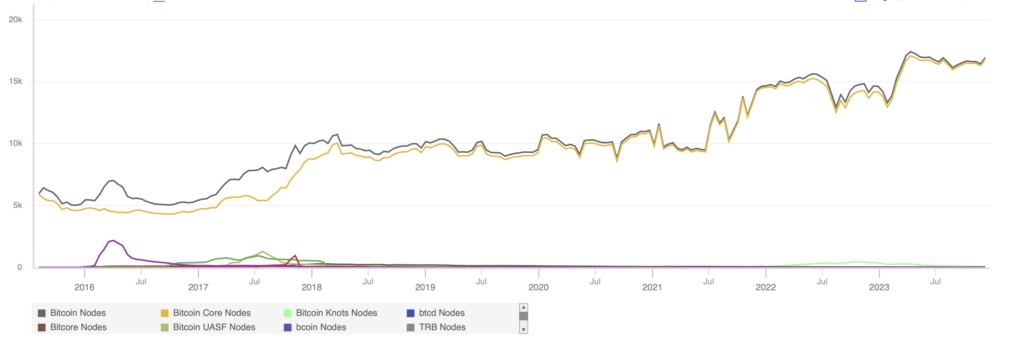Bitcoin Core v26 will be released with 1% of nodes upgraded on launch day.

Bitcoin Core version 26.0 was released yesterday, December 6th, and 1% of Bitcoin nodes were upgraded within the first 24 hours. This latest update to the underlying software used to interact with the Bitcoin network introduces major improvements aimed at improving security and network performance.
Bitcoin Core, often likened to Bitcoin’s operating system, ensures rules and standards for how transactions and blocks are processed. Boasting a 99% adoption rate among node operators, it is the backbone of the Bitcoin network and allows users to interact with the Bitcoin blockchain. Although it has not supported mining since 2016, it plays an important role in the Bitcoin ecosystem.
A full node is a computer that runs Bitcoin software and maintains a copy of the entire Bitcoin blockchain. They verify and block transactions and pass this information on to other nodes and miners to keep the network in sync. On the other hand, miners who create new blocks on the Bitcoin blockchain use specialized mining software such as CGMiner.
The release of a new version of Bitcoin Core is always a significant event. However, it is up to each node operator to decide when to upgrade. Some may upgrade immediately to take advantage of new features or improvements, while others may wait to see if bugs or issues appear.
The v26.0 update includes several optimizations that improve networking connectivity and the speed of initial blockchain synchronization of nodes. Key features include preliminary support for new network data transfer protocols, improved resiliency against Eclipse attacks, faster node bootstrapping with UTXO snapshots, and various remote procedure call (RPC) improvements.
Looking ahead, developer stated that the upcoming v27 update could address the ‘problems’ caused by Bitcoin Ordinals – unique Satoshis that resulted in blockchain bloat, mempool congestion, and high transaction fees. However, Ordinals supporters, including MicroStrategy’s Michael Saylor, argue that removing Ordinals would “impede application development (…and) also destroy the Bitcoin mining network.”
Dashjr, a leading critic of Ordinals and Bitcoin Core developer, said:
“Bitcoin Core has allowed users since 2013 to set limits on the size of additional data (`-datacarriersize`) in transactions they relay or mine. (Ordinals) circumvents this limitation by obfuscating data into program code.”
Additionally, given that 44% of Bitcoin nodes are currently running on software that is more than a year old, it will be interesting to see the adoption rate of v27.0 if it removes Inscriptions (Ordinals). Other Bitcoin software such as Knots and btcd are available, but current adoption is minimal.

Adoption of Bitcoin Core version distribution.
The rate at which node operators upgrade to new versions of Bitcoin Core can vary greatly and is influenced by many factors. These include the perceived benefits of the new version, the stability of the new release, and personal or organizational resources and policies.
Historically, adoption of new Bitcoin Core versions has been gradual. For example, Dashjr estimated in March that 41% of node operators had adopted and were running the latest software. Prior to the release of v26.0, only 20% of nodes were running the latest v25.1, with 36% choosing to continue using v25.0. Additionally, in the five years since SegWit launched, half of adoption has occurred since June 2021. SegWit compatibility is currently on 95% of nodes.
Bitcoin Core v26.0 has been adopted by approximately 1% of nodes at press time. Relatively slow initial adoption rates are not uncommon, as node operators often take time to evaluate new releases before deciding to upgrade. You may also want to wait until potential bugs or issues are identified and resolved before adopting a new version. Currently in v26.0 there are only a handful of issues listed, none of which appear to be mission critical and are mainly related to build issues in certain environments. But excitement about new integer Bitcoin Core versions, which typically occur every six to seven months, has sparked “general Bitcoin questions” from some developers.
Upgrading to a new version of Bitcoin Core requires node operators to safely shut down their current version and securely back up their wallet.dat file before upgrading. This process may require time and resources, which may also impact the speed of adoption.
You can read the full release notes for Bitcoin Core here and learn how to run a Bitcoin node at home here.



